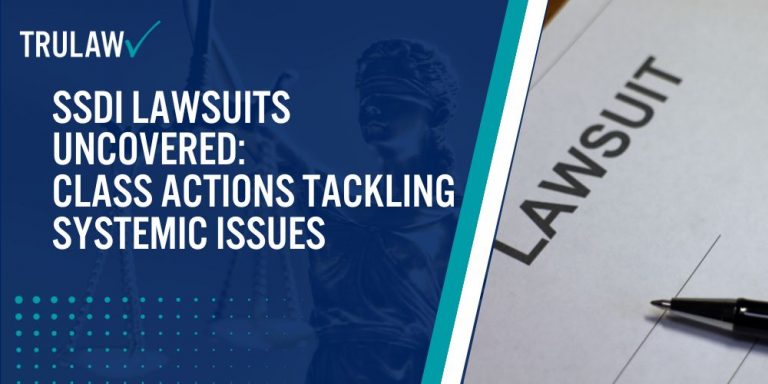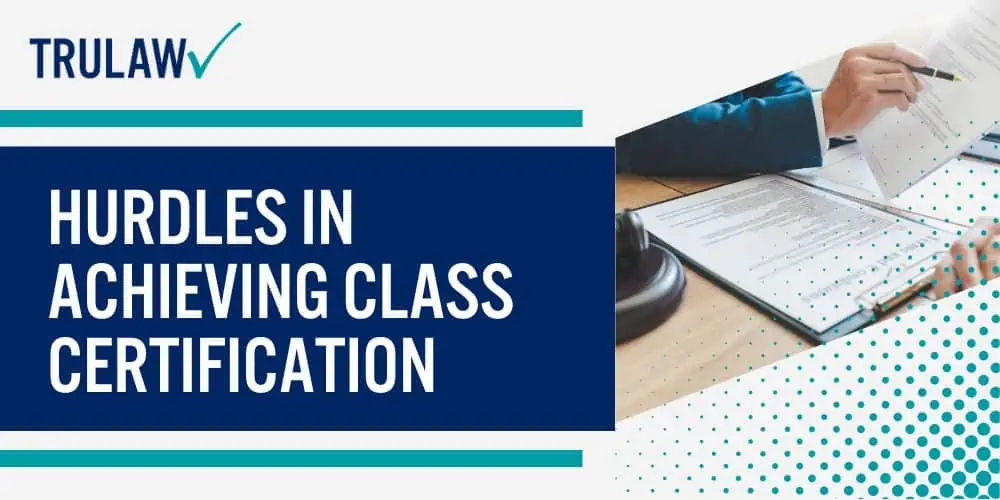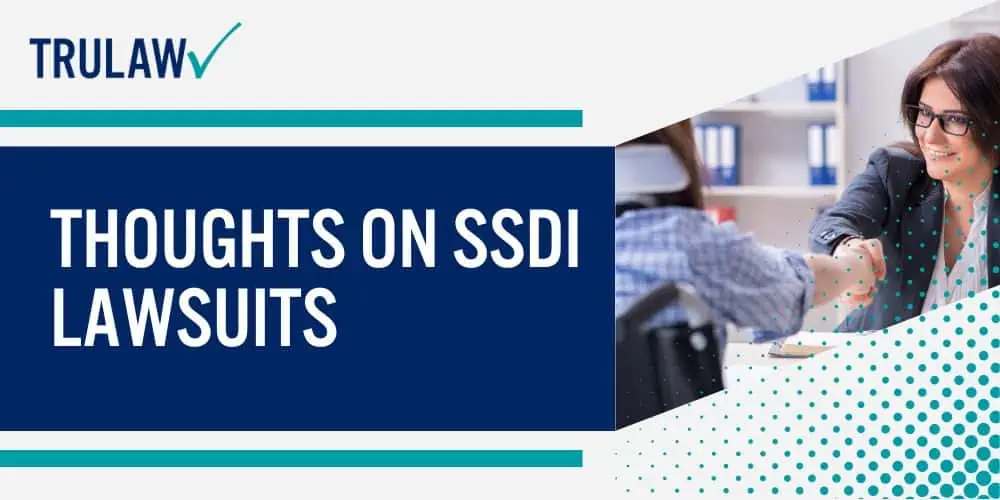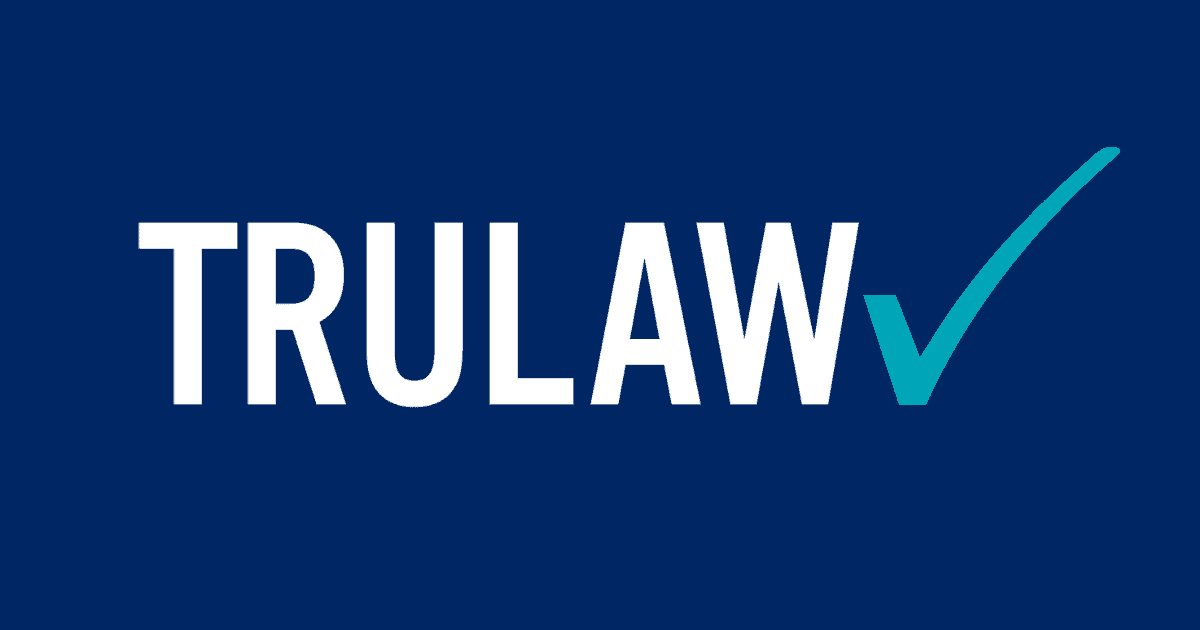SSDI Lawsuits Uncovered: Class Actions Tackling Systemic Issues
- Last Updated: July 14th, 2025

Attorney Jessica Paluch-Hoerman, founder of TruLaw, has over 28 years of experience as a personal injury and mass tort attorney, and previously worked as an international tax attorney at Deloitte. Jessie collaborates with attorneys nationwide — enabling her to share reliable, up-to-date legal information with our readers.
Legally Reviewed
This article has been written and reviewed for legal accuracy and clarity by the team of writers and legal experts at TruLaw and is as accurate as possible. This content should not be taken as legal advice from an attorney. If you would like to learn more about our owner and experienced injury lawyer, Jessie Paluch, you can do so here.
Fact-Checked
TruLaw does everything possible to make sure the information in this article is up to date and accurate. If you need specific legal advice about your case, contact us by using the chat on the bottom of this page. This article should not be taken as advice from an attorney.
Key takeaways:
- Class actions serve as critical cases that can precipitate change on a national scale.
- In an individual lawsuit, one person files a suit against another party, typically the Social Security Administration (SSA).
- Notable lawsuits against the Social Security Administration (SSA) highlight systemic flaws in the Social Security Disability Insurance (SSDI) system.
SSDI Lawsuits Uncovered: Class Actions Tackling Systemic Issues
The realm of Social Security Disability Insurance (SSDI Lawsuits) is not devoid of legal complexities.
One such complexity arises in the form of class action lawsuits, a collective legal action that highlights systemic issues within the SSDI system.
These lawsuits often stem from perceived inadequacies in SSA policy, Title II provisions, or SSI benefits management, particularly concerning special needs trusts.

The SSDI Class Action Lawsuit serves as critical cases that can precipitate change on a national scale.
They bring to light conditions that necessitate immediate attention and potentially prompt amendments to existing policies or procedures.
The impact of these lawsuits on the SSDI system is profound, leading to modifications that can affect the status of countless beneficiaries.
These collective actions are especially pertinent during times of national emergency when swift resolution is vital for those reliant on SSDI benefits.
Table of Contents
Defining Class Action Lawsuits In SSDI
A class-action lawsuit within the context of Social Security Disability Insurance (SSDI) is a legal action taken by a group of individuals collectively.
These individuals, referred to as ‘the class’, are all affected by the same issue related to their SSDI benefits.
The distinguishing features between individual and class action lawsuits in SSDI lie primarily in the number of plaintiffs and the nature of the claim.
In an individual lawsuit, one person files a suit against another party, typically the Social Security Administration (SSA).
The claim usually pertains to personal grievances such as denial or discontinuation of benefits.
On the other hand, class action lawsuits involve multiple plaintiffs who have experienced similar issues with their SSDI benefits.
They band together to sue a common defendant – again, often the SSA.
This type of lawsuit can address systemic problems affecting numerous beneficiaries.
To qualify as a class action lawsuit in SSDI, the following conditions must be met:
- Numerosity: There must be too many plaintiffs for individual lawsuits to be practical.
- Commonality: All members of the class must share legal or factual questions.
- Typicality: The representative parties’ claims or defenses should be representative of the class.
- Adequacy: The representative parties must sufficiently protect the class’s interests.
Representative individuals ensure fair resolution for all, this would meet the requirements.
This method promotes efficiency and reduces litigation costs and court time.
However, class action lawsuits in SSDI are complex and require expert legal guidance.
Identifying Systemic Issues In SSDI
Common Problems in SSDI
The Social Security Disability Insurance (SSDI) system, designed to provide disability insurance benefits to individuals who cannot work due to a disability, is plagued by numerous systemic issues.
These problems often create hurdles for those seeking supplemental security income SSDI benefits.
One of the most significant issues is the complexity and ambiguity surrounding the determination of insured status.
This can lead to inconsistencies in benefit awards and denials.
Another problem is the prolonged processing times for applications, which can leave applicants without essential support for extended periods.
Moreover, there’s an issue with improper payments where some recipients might receive more or less than they should.
Lastly, there’s a lack of transparency concerning how decisions are made about who qualifies for benefits and why.
Lawsuits Stemming from Systemic Issues

These systemic issues within the SSDI system have prompted multiple class-action lawsuits over time.
Legal action typically arises when applicants or beneficiaries believe that their rights have been violated due to these systemic problems.
For instance, claimants may file lawsuits if they feel they’ve been unfairly denied benefits due to ambiguous rules about insured status.
In other cases, lawsuits may stem from excessive delays in processing applications or making benefit determinations.
Case Examples
Notable lawsuits against the Social Security Administration (SSA) highlight systemic flaws in the Social Security Disability Insurance (SSDI) system.
These include wrongful termination of SSI benefits due to miscalculated income, excessive delays in disability determination hearings, and allegations of biased medical experts leading to unfair benefit denials.
These cases emphasize the pressing need for reform to ensure timely and fair distribution of disability benefits.
Exploring Notable SSDI Class-Action Lawsuits
Past Cases and Outcomes
Several SSDI class-action lawsuits have shaped the landscape of Social Security Disability Insurance (SSDI).
For instance, the Martinez v. Astrue lawsuit in the United States compelled the Social Security Administration (SSA) to revise its policy on using outstanding arrest warrants as grounds for suspending or denying benefits.
In another case, Clark v. Astrue, SSA had to cease its practice of suspending or denying benefits to individuals with outstanding felony arrest warrants without first determining if they were actually fleeing prosecution.
These cases not only affected the lives of many disabled workers but also set a precedent for future SSDI lawsuits.
Impact on Current Laws and Regulations

These landmark cases significantly influenced current laws and regulations concerning SSDI.
The outcomes led to changes in SSA’s administrative notice procedures, ensuring that due process is served before any action affecting an individual’s income from employment is taken.
For example, post Martinez v. Astrue, SSA can no longer suspend or deny benefits based solely on an outstanding warrant.
They must now provide evidence that the person is actively avoiding law enforcement or court, thereby protecting a disabled child or worker’s right to income despite their previous work status.
Lessons Learned
Landmark SSDI lawsuits offer valuable lessons:
- They highlight the importance of due process: SSA must now adhere strictly to procedural requirements before taking actions that might affect a beneficiary’s employment income.
- They underline the significance of vocational guidelines: These cases emphasize how crucial it is for SSA to consider an individual’s ability to perform previous work.
- They stress health considerations: The rulings underscored that health conditions should be central in assessing disability claims.
The impact these notable cases had on shaping current laws and regulations cannot be understated.
Their influence extends beyond just those who were part of the lawsuit – they have set precedents that protect the rights of all SSDI recipients in the United States.
By examining these cases, we gain a deeper understanding of how SSDI operates today and how it may evolve in the future.
Challenges In Class Certification For SSDI Lawsuits
Class certification in Social Security Disability Insurance (SSDI) lawsuits often presents a labyrinth of legal challenges.
The process is not as straightforward as it may seem, primarily due to the intricate nature of the social security disability system and the diverse circumstances of claimants.
Hurdles in Achieving Class Certification

Class certification, governed by Federal Rules of Civil Procedure 23, involves four stringent prerequisites: numerosity, commonality, typicality, and adequacy.
These requirements, which include factors like the number of class members, shared legal or factual questions, typical claims or defenses, and fair representation, can be difficult to meet due to individual differences among SSDI claimants, including their medical conditions, work histories, and ages.
Factors Courts Consider for Granting Class Status
Here are some of what the Courts weigh several factors when deciding whether to grant class status in an SSDI lawsuit:
- Whether a well-defined community of interest exists among class members
- Whether common questions predominate over individual issues
- Whether a class action would be superior to other methods for fair and efficient adjudication
Each factor requires careful scrutiny, making it difficult for plaintiffs to secure a favorable decision.
Overcoming Certification Challenges
Despite these obstacles, skilled plaintiffs’ attorneys employ various strategies to overcome certification challenges:
They meticulously craft their complaints to highlight shared legal issues that overshadow individual differences.
They present compelling evidence showing systemic flaws within the SSDI system that affect all potential class members similarly.
They argue convincingly about how a collective lawsuit would provide an efficient solution compared with multiple individual suits.
For instance, in Padro v. Astrue, plaintiffs successfully argued for class certification by showing that a group of Administrative Law Judges had a policy of denying SSDI claims at rates significantly higher than the national average.
Benefits And Drawbacks Of Class Actions In SSDI
Advantages of Collective Legal Approach
A collective legal approach, such as class actions, can provide several advantages for claimants pursuing SSDI benefits.
One primary advantage is the shared cost aspect.
By banding together in a lawsuit, individuals can distribute the financial burden of litigation among all members of the group, making it more affordable for each person.
Increased bargaining power is another significant benefit.
A large group suing collectively often carries more weight than an individual claimant would alone.
This increased leverage can lead to better negotiation outcomes with insurance companies or other entities responsible for providing disability benefits.
For example, consider a case where numerous workers from a coal mine develop health issues due to prolonged exposure to harmful conditions and decide to file for black lung benefits collectively.
Their combined voices could potentially exert greater pressure on the mining company or relevant insurance provider.
Potential Downsides

Despite these advantages, there are potential downsides to consider when opting for a class action approach in SSDI lawsuits.
Prolonged litigation timeframes are one such drawback.
Class actions typically involve complex legal procedures which can extend the duration of the case significantly longer than individual lawsuits.
Another possible downside could be dilution of individual claims’ value.
In a class action suit, any compensation benefits awarded are divided among all participants equally or based on some predetermined formula.
Therefore, if an individual’s damages far exceed those of others within the group, they might receive less than what their claim is actually worth.
Weighing Pros and Cons
Given these factors, weighing up pros and cons based on specific case circumstances becomes crucial before deciding whether to pursue a class action lawsuit for SSDI benefit.
If your main concern is affordability and you lack sufficient resources to bear SSDI litigation costs individually, joining a class action might be beneficial.
If your case has unique aspects that could potentially increase its value significantly compared to others, filing an individual lawsuit could be more advantageous.
Notable Class Action SSDI Lawsuits
High-Profile Cases
Two landmark Social Security Disability Insurance (SSDI) cases, Richardson v. Perales (1971) and Astrue v. Capato (2012), significantly impacted SSDI procedures and policy.
The former established the admissibility of written medical reports in disability hearings without the need for the authors’ presence.
The latter ruled that SSDI survivor benefits eligibility hinges on state inheritance laws.
These rulings reshaped SSDI claims, appeals, and Social Security Administration policies.
Impact on Policies and Procedures

The landmark cases, Richardson v. Perales and Astrue v. Capato, significantly influenced SSDI policies.
Richardson v. Perales allowed written medical reports as evidence in disability hearings, greatly simplifying the process.
Astrue v. Capato defined ‘child’ under social security laws, providing clear guidelines for eligible beneficiaries.
Legal Strategies Employed
The strategies in significant class action lawsuits often depend on interpreting existing laws or identifying procedural errors.
For instance, Richardson v. Perales contested the fair use of evidence, while Astrue v. Capato questioned the definition of a ‘child’ under social security laws.
These strategies have influenced outcomes and offered insights into navigating complex SSDI litigation.
Engaging Legal Representation For Class Actions
The process of securing experienced legal representation in SSDI class action lawsuits is critical.
An attorney with a deep understanding of the law and vast experience in handling similar cases can significantly increase the likelihood of a favorable outcome.
Choosing the Right Lawyer

When choosing an attorney or law firm to handle an SSDI class action lawsuit,
Here are some factors should be considered:
- Experience: It’s essential to find a disability attorney who has handled personal injury cases similar to yours.
- Fees: Understanding attorney fees upfront can prevent any surprises later on.
- Reputation: A lawyer’s reputation can speak volumes about their ability to successfully represent you.
A competent legal counsel plays an instrumental role in navigating complex litigation processes.
The court system can be daunting, especially when dealing with SSDI lawsuits that often involve intricate laws and regulations.
Role of Legal Counsel
Legal representation is invaluable in many aspects of an SSDI class action lawsuit:
- Understanding the Law: Your attorney will help interpret the justice act, state court regulations, and other relevant laws applicable to your case.
- Filing Claims: The claimant needs assistance filing claims correctly and within stipulated timelines.
- Negotiating Settlements: Lawyers play a vital role in negotiating compensation settlements with opposing counsel or insurance companies.
- Appealing Decisions: If dissatisfied with the court’s decision, your lawyer can appeal to higher courts or appeals council.
Wrapping Up: Concluding Thoughts On SSDI Lawsuits
The realm of Social Security Disability Insurance (SSDI lawsuits), particularly class-action suits, is complex and multifaceted.
Understanding the intricacies of these legal proceedings, the systemic issues within the SSDI system, and the challenges associated with class certification can provide valuable insights.

Notable class action lawsuits in this field underscore the significance of these cases and their potential to effect change.
Legal representation plays a pivotal role in navigating these complexities.
Therefore, seeking professional advice is crucial for those considering participation in a class action lawsuit related to SSDI.
The benefits and drawbacks of such actions must be carefully weighed before proceeding.
Social Security Disability Insurance Frequently Asked Questions
-
There have been several significant SSDI class-action lawsuits over the years that have helped shape laws and regulations surrounding disability insurance claims.
Qualified medical professional can also help in quality disability determinations for your class action disability claim.
-
Legal representation provides guidance and support throughout an SSDI lawsuit.
Federal court or Federal District Court with the Administrative Law Judge will have substantial gainful activity to receive expedited processing for class action lawsuit.
-
Obtaining class certification for an SSDI lawsuit can be challenging due to some lack of medical exam for prior determinations in terminal illness.
-
When applying for SSDI, your main concerns are qualifying as disabled under the SSA’s definition of being disabled and earning enough work credits before you apply for benefits.
The program does not limit the amount of cash, assets, or income you have when you apply for disability benefits.
-
Greater judicial efficiency. A class action lawsuit is decided by one judge in one court.
Thus, the litigation will take up less cumulative court time and involve fewer judges.
Greater uniformity of recoveries among similar plaintiffs.

Managing Attorney & Owner
With over 25 years of legal experience, Jessica Paluch-Hoerman is an Illinois lawyer, a CPA, and a mother of three. She spent the first decade of her career working as an international tax attorney at Deloitte.
In 2009, Jessie co-founded her own law firm with her husband – which has scaled to over 30 employees since its conception.
In 2016, Jessie founded TruLaw, which allows her to collaborate with attorneys and legal experts across the United States on a daily basis. This hypervaluable network of experts is what enables her to share the most reliable, accurate, and up-to-date legal information with our readers!
Additional Social Security Disability Insurance resources on our website:
Here, at TruLaw, we’re committed to helping victims get the justice they deserve.
Alongside our partner law firms, we have successfully collected over $3 Billion in verdicts and settlements on behalf of injured individuals.
Would you like our help?
At TruLaw, we fiercely combat corporations that endanger individuals’ well-being. If you’ve suffered injuries and believe these well-funded entities should be held accountable, we’re here for you.
With TruLaw, you gain access to successful and seasoned lawyers who maximize your chances of success. Our lawyers invest in you—they do not receive a dime until your lawsuit reaches a successful resolution!
AFFF Lawsuit claims are being filed against manufacturers of aqueous film-forming foam (AFFF), commonly used in firefighting.
Claims allege that companies such as 3M, DuPont, and Tyco Fire Products failed to adequately warn users about the potential dangers of AFFF exposure — including increased risks of various cancers and diseases.
Depo Provera Lawsuit claims are being filed by individuals who allege they developed meningioma (a type of brain tumor) after receiving Depo-Provera birth control injections.
A 2024 study found that women using Depo-Provera for at least 1 year are five times more likely to develop meningioma brain tumors compared to those not using the drug.
Suboxone Tooth Decay Lawsuit claims are being filed against Indivior, the manufacturer of Suboxone, a medication used to treat opioid addiction.
Claims allege that Indivior failed to adequately warn users about the potential dangers of severe tooth decay and dental injuries associated with Suboxone’s sublingual film version.
Social Media Harm Lawsuits are being filed against social media companies for allegedly causing mental health issues in children and teens.
Claims allege that companies like Meta, Google, ByteDance, and Snap designed addictive platforms that led to anxiety, depression, and other mental health issues without adequately warning users or parents.
Transvaginal Mesh Lawsuits are being filed against manufacturers of transvaginal mesh products used to treat pelvic organ prolapse (POP) and stress urinary incontinence (SUI).
Claims allege that companies like Ethicon, C.R. Bard, and Boston Scientific failed to adequately warn about potential dangers — including erosion, pain, and infection.
Bair Hugger Warming Blanket Lawsuits involve claims against 3M — alleging their surgical warming blankets caused severe infections and complications (particularly in hip and knee replacement surgeries).
Plaintiffs claim 3M failed to warn about potential risks — despite knowing about increased risk of deep joint infections since 2011.
Baby Formula NEC Lawsuit claims are being filed against manufacturers of cow’s milk-based baby formula products.
Claims allege that companies like Abbott Laboratories (Similac) and Mead Johnson & Company (Enfamil) failed to warn about the increased risk of necrotizing enterocolitis (NEC) in premature infants.
Here, at TruLaw, we’re committed to helping victims get the justice they deserve.
Alongside our partner law firms, we have successfully collected over $3 Billion in verdicts and settlements on behalf of injured individuals.
Would you like our help?

